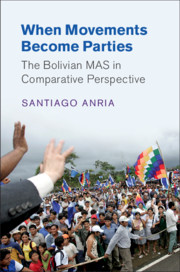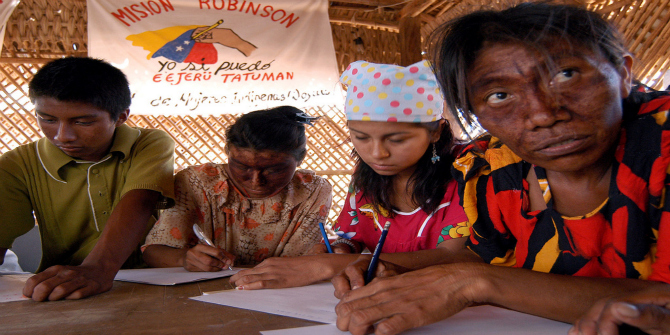In When Movements Become Parties: The Bolivian MAS in Comparative Perspective, Santiago Anria argues that movement-based parties do not inevitably morph into oligarchies run by professional party elites, drawing on the example of Bolivia’s Movement towards Socialism (MAS) and its hybrid organisational structure. With the book’s ideas about to be tested in real time following the resignation of Bolivian President and MAS leader Evo Morales in 2019, Anria draws on a creative research methodology and ample evidence from extensive field research to fill a gap in the literature surrounding so-called personalist Latin American political parties, writes Sally Sharif.
When Movements Become Parties: The Bolivian MAS in Comparative Perspective. Santiago Anria. Cambridge University Press. 2019.
 Find this book (affiliate link):
Find this book (affiliate link): ![]()
In one of his frequent meetings with the umbrella union of coca growers in Cochabamba, Bolivia, then Bolivian President Evo Morales tells union leaders and the organisation’s rank and file that he is there to inform them of what the government is doing and to ask them for proposals. At the end of the meeting, a union leader tells Anria, ‘I thank the president for that, for always coming here to talk to the rank and file. But the representatives and the ministers usually do not come.’ It’s an incredible scene where the leader of a country, considered by many as a power-hungry autocrat, welcomes input from coca growers on major policy decisions.
How did Morales’s Movement towards Socialism (MAS) manage to grow within ten years into an organic national party without falling into top-down personalist control, which has trapped most Latin American populist parties? What does it take to maintain a viable movement-based, leftist party in Latin America? MAS started as a social movement by indigenous coca growers in northern Bolivia to fight against the country’s neoliberal policies and coca eradication efforts by the United States. Santiago Anria’s When Movements Become Parties: The Bolivian MAS in Comparative Perspective (2019) presents MAS as an anomaly among left-wing movement-based parties: it managed to resist being hijacked by party elites, remaining open and accountable to its support base.
It was either Anria’s dream or nightmare that the book’s publication coincided with mass protests in Bolivia that led to the resignation of Morales, his Vice President and both heads of Congress. Anria argues that MAS has successfully avoided top-down control because of its hybrid organisational structure, a fusion of social movement and political party. The book traces the foundation of MAS as a political party to the social movement surrounding one man – Morales – that started with a narrow agenda but widened its reach to an electorate encompassing 64 per cent of the population. The book’s central contribution is the finding that movement-based parties do not inevitably morph into oligarchies run by professional party elites. There exist ways to counteract the centralising trend in a party’s evolution.
 Through a ‘thick’ analysis of the historical context and behaviour of MAS, Anria traces the process through which its hybrid structure was formed during the years of expansion up to 2009. MAS has the support of two distinctive social coalitions. The central coalition is based in the rural sector and consists of coca growers in the northern lowland region of Chapare as well as three national-level peasant organisations. The peripheral coalition consists of a broader set of urban-popular organisations. The party strategises differently in relation to these two coalitions: bottom-up vis-à-vis its central coalition and top-down when facing the peripheral coalition.
Through a ‘thick’ analysis of the historical context and behaviour of MAS, Anria traces the process through which its hybrid structure was formed during the years of expansion up to 2009. MAS has the support of two distinctive social coalitions. The central coalition is based in the rural sector and consists of coca growers in the northern lowland region of Chapare as well as three national-level peasant organisations. The peripheral coalition consists of a broader set of urban-popular organisations. The party strategises differently in relation to these two coalitions: bottom-up vis-à-vis its central coalition and top-down when facing the peripheral coalition.
MAS has a loose bureaucratic structure, which provides opportunities for its core social bases to act autonomously. The party did not co-opt its core constituency; rather, it grew organically out of the coca-growing unions, which inform party policies. In the urban areas, however, MAS faced a different problem. The existing social organisations in the large cities weren’t natural allies of rural cocaleros. Anria finds a deliberate plan by the party to win over previously existing organisations at the city and neighbourhood levels by penetrating their social networks, co-opting their leaders and controlling them. ‘The MAS, therefore, was not an organic product of these cities. Rather, it inserted itself into La Paz and El Alto as something foreign’ (81). These two distinctive social coalitions determine how MAS selects candidates, what substantive issues are considered on the national agenda and how they are decided.
Unlike other laudatory and optimistic accounts of MAS as the first political party in Latin America with indigenous roots, Anria offers a realistic picture by including the party’s co-optation strategies and top-down decision-making in urban areas, thus allowing the reader to anticipate MAS’s deteriorating support in larger cities and to speculate on the party’s future. Through a creative research methodology and ample evidence from extensive field research, Anria’s book fills the gap in literature surrounding so-called personalist Latin American parties, and especially how their organisational structure evolves over time.
The book’s last chapter includes a cross-national comparative analysis of MAS with Brazil’s PT (Worker’s Party) and Uruguay’s FA (Broad Front). Anria demonstrates the mistaken trend in Latin American literature where MAS is compared to Ecuador’s PAIS (Proud and Sovereign Homeland) and Venezuela’s MVR (Fifth Republic Movement) for the similarity in leadership style of Morales to Rafael Correa and Hugo Chavez, respectively. MAS, demonstrates Anria, is most similar to Uruguay’s FA in leaving open channels for their social bases to influence decision-making in both candidate selection and the policy-making sphere.
The book sets itself the goal of explaining how ‘participation can be promoted and sustained within contemporary governing parties that have social movements, peasant associations, labor unions, and other popular organizations as their core social base’ (6-7). Measured against this ambition, however, Anria falls short of such a prescription, going only so far as describing how MAS originated from and sustained, rather than promoted or started, the substantive bottom-up participation among its core constituency.
Anria underplays the authoritarian tendencies of Morales, especially in the rural areas where he enjoys complete support. Anria mentions in passing that ‘Dirigentes [union leaders] play a key role in shielding Morales from grass-roots criticism, which helps to strengthen his leadership’ (85), but he does not attend to why such an attentive leader should shy away from taking criticism of unpopular policies among his support base. In the area of candidate selection, we also see Morales’s centralising tendencies: ‘if conflict emerges among competing organizations, the MAS tends to concentrate decision-making power in the hands of a small party elite – and even Morales himself’ (116).
An empirical question Anria raises in the book is whether Morales’s then-proposed next term in office (2020-25) would translate into growing power concentration in the party. Although Anria critically discusses Morales’s apparent intention to rule for the long term, he does not raise the obvious follow-up question: why didn’t Morales pick a successor if he trusted that the party was organisationally strong enough to run the country without him? If he trusted that MAS had enough electoral support in the core and peripheral coalitions, he could have passed on the leadership of the party to someone else after the 2016 proposed constitutional amendments to allow the President and Vice President to run for a third consecutive term were voted down.
Anria’s book is about to be tested in real time. MAS should outlast Morales, continuing representation of the traditionally under-represented classes and ethnicities in Bolivia, if it has garnered enough political support and extended its horizontal ties in the fourteen years it led the country. There are a few possible outcomes in the country’s near future, depending on how MAS manages the post-Morales political life of the country. If Anria is right in arguing that MAS, compared to similar political parties in Latin America that emerged out of social movements, has been successful in transcending a top-down control structure, it should be able to sustain itself without Morales.
Note: This review gives the views of the author, and not the position of the LSE Review of Books blog, or of the London School of Economics. The LSE RB blog may receive a small commission if you choose to make a purchase through the above Amazon affiliate link. This is entirely independent of the coverage of the book on LSE Review of Books.
Image Credit: Evo Morales leads a May Day march, 2014. Eneas De Troya. CC BY 2.0.







